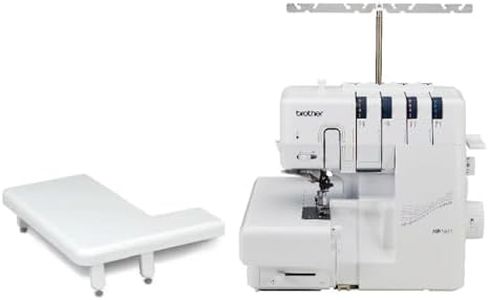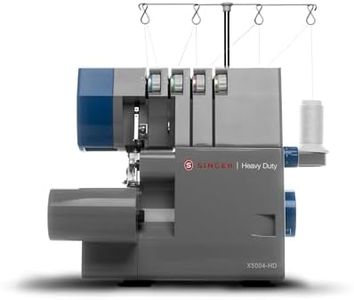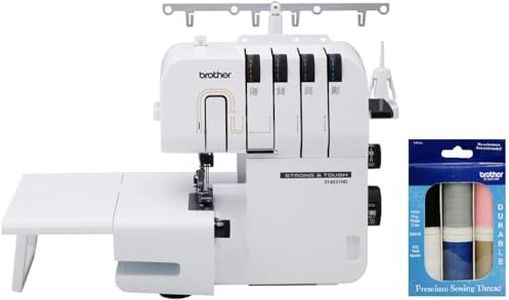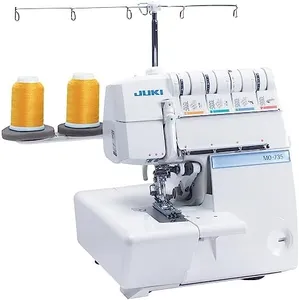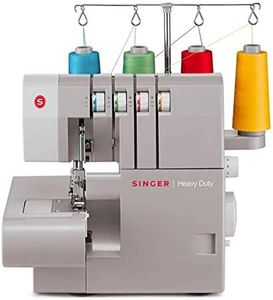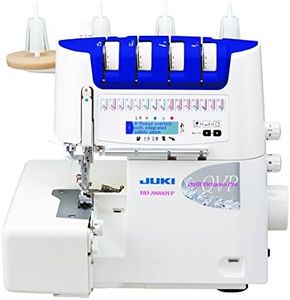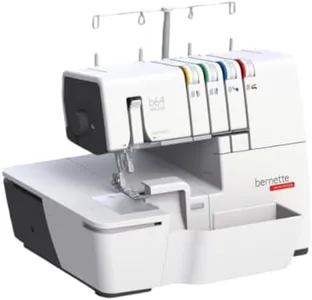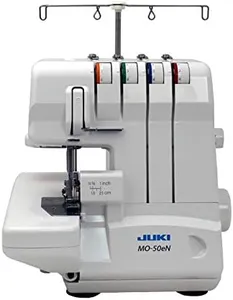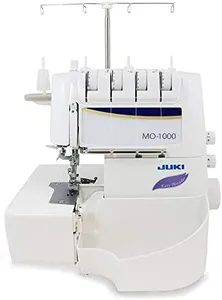10 Best Self Threading Serger 2025 in the United States
Our technology thoroughly searches through the online shopping world, reviewing hundreds of sites. We then process and analyze this information, updating in real-time to bring you the latest top-rated products. This way, you always get the best and most current options available.

Our Top Picks
Winner
Brother AIR1800 Air Serger with Jet Air Threading, 2/3/4 Thread, LED Lit Work Area, Plus Wide Table Extension and 4-Piece Thread Cones Starter Pack
Most important from
75 reviews
The Brother AIR1800 Air Serger stands out mainly for its innovative air threading system, which uses a blast of air to thread the loopers quickly, making it much easier and faster to change threads compared to traditional sergers. This feature is especially helpful for those who find threading tricky or time-consuming. It supports 2, 3, or 4-thread stitching with color-coded guides, which helps you stay organized and handle multiple threads without confusion. The machine offers a good variety of stitches including flatlock, overlock, and rolled hem, making it suitable for working on stretchy or specialty fabrics with neat finishes.
The included wide table extension expands your workspace, which is a nice bonus for handling larger projects comfortably. The starter pack with four high-quality thread cones is also a practical addition to get you going right away. Adjustable tension is available, allowing you to fine-tune the stitch quality based on different fabric types. While precise speed specifications are not detailed, the machine is known for reliable performance.
The serger weighs over 21 pounds, which may make it less portable if you plan to move it frequently. Additionally, while the air threading is a great time-saver, sergers with more detailed speed controls or additional stitch options might better suit users looking for advanced customization. This model is well-suited for those seeking a simplified threading experience without sacrificing stitch quality, especially crafters working with various thread counts and fabric types.
Most important from
75 reviews
SINGER X5004-HD Metal Frame Serger & Overlock Machine | 2-3-4 Stitch Capability, 8 Built-In Stitches, 1300 Stitches per minute, Adjustable Differential Feed & 2 LED Lights (Grey/Blue)
Most important from
1410 reviews
The SINGER X5004-HD Metal Frame Serger is a solid choice for both beginners and experienced sewers looking for a reliable and versatile machine. Its heavy-duty metal frame ensures durability, making it suitable for frequent use and capable of handling thicker fabrics like denim and upholstery without skipping stitches. With the ability to use 2, 3, or 4 threads and a variety of stitch options, it’s great for a wide range of sewing projects, from practical seams to decorative edges.
One of its standout features is the larger cutting knife, which is 60% bigger than standard ones, allowing for clean and efficient cutting of heavy materials. Plus, the machine operates at a high speed of up to 1,300 stitches per minute, which is fantastic for completing large projects quickly. The adjustable differential feed is another bonus, helping to prevent puckering on lightweight fabrics and enabling smooth gathering on stretchy materials.
While the machine has many strong points, it does come with a learning curve, especially for those new to serging. Threading can be tricky, despite it being designed for ease. Some users may find the initial setup and threading process frustrating before they get the hang of it. Additionally, while it has a comprehensive accessory kit, some might wish for more advanced features or additional stitch options.
The SINGER X5004-HD is a great investment for those looking to expand their sewing capabilities, particularly if you often work with thicker fabrics. While it may take some patience to learn how to use it effectively, the end results are professional and satisfying.
Most important from
1410 reviews
Juki MO-3000QVP Akane Air Threader Serger Machine
Most important from
6 reviews
The Juki MO-3000QVP Akane Air Threader Serger Machine is designed for both seasoned sewers and beginners looking for an efficient and user-friendly option. One of its standout features is the air threading system, which simplifies the often frustrating process of threading the machine—ideal for those who may find traditional threading techniques daunting. This serger supports multiple threads, enabling a variety of stitch options that cater to different sewing projects like hems, seams, and decorative edges.
The differential feed feature enhances the machine's ability to manage different fabric types, minimizing puckering or stretching, which is particularly beneficial when working with knits or lightweight materials. With adjustable tension settings, users can easily tailor their stitching to achieve the desired look and finish, providing an extra level of control.
In terms of speed, the Juki MO-3000QVP operates quickly, making it a great choice for those who need to complete projects efficiently. However, for users new to sergers, the machine’s speed might feel overwhelming at first, so a learning curve may be involved. One potential drawback to consider is its weight; at 25 pounds, it may not be the most portable option if you plan to move it around frequently.
Most important from
6 reviews
Buying Guide for the Best Self Threading Serger
Choosing the right self-threading serger can significantly enhance your sewing projects by providing professional finishes and saving you time. A self-threading serger is a specialized sewing machine that trims the fabric edge and encloses it with an overlock stitch, all in one step. The self-threading feature simplifies the threading process, making it more user-friendly, especially for beginners. When selecting a self-threading serger, consider the following key specifications to ensure you pick the best fit for your needs.FAQ
Most Popular Categories Right Now
